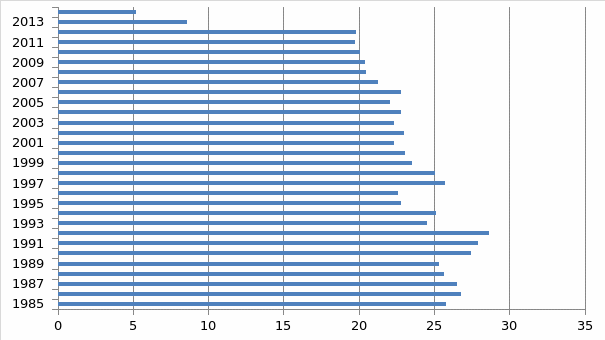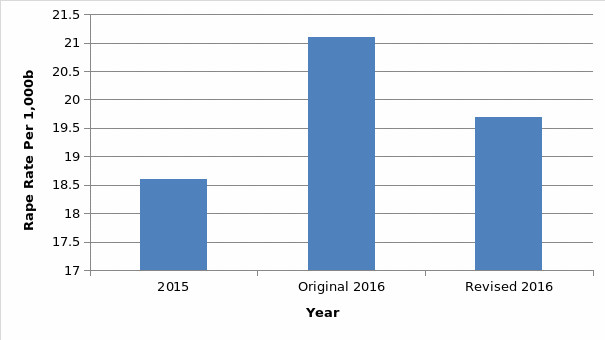Date or Acquaintance Rape
Despite the increasing awareness of the issue of sexual assault, the justice system and society still show some reluctance in recognizing acquaintance rape as unacceptable or even criminal behavior. This primarily arises from the complex issues of sexual consent. This paper uses American’s national crime measure statistical programs to provide a comprehensive overview of the present knowledge regarding the incidence and prevalence of rape, the traits of the offenders who prey on victims by committing date rape, and the response of the justice system to such crimes.
Statistical Programs Measuring Crime in the U.S
The United States Department of Justice uses the Uniform Crime Reporting (UCR) and the National Crime Victimization Survey (NCVS) to measure crime (UCR, 2019). Over the years, there has been a negative trend in the rate of legacy rape in the U.S (UCR, 2019).

The strength of the UCR program is that the data present is derived from actual criminal accounts, thus independent of bias. Its weakness is that it only includes rape accounts of only women.
The NCVS program was created to complement the UCR. The rape rates presented by the NCVS are relatively lower as compared to the UCR. It includes rape rate crimes in cases in which both sexes were victimized.

Its strength is that it constitutes information concerning crimes that are both reported and not reported to law enforcement. However, its weakness is that the data collection method used is susceptible to bias; hence information might be inaccurate.
Types of Rape
There are several types of rape. First is the date or acquaintance rape. This is where both the victim and the offender are familiar with each other. Both parties can either be acquaintances or are romantically involved. The second is stranger rape, whereby the offender is unfamiliar to the victim. The third is statutory rape whereby the victim is below the age of consent. However, unlike other types of rape, in statutory rape, even when the sexual act is consensual, the act is still considered to violate the law. Last but not least, there is spousal rape where both parties are in a marital relationship. Victims and offenders might be partners or ex-partners.
Types and Uses of Date Rape Drugs
The use of date rape drugs to facilitate sexual violence is a problematic issue in the U.S (Illinois State Police, 2019). In most cases, the method of operation is similar, i.e., the drug is slipped into the drink of the intended victim without their knowledge. Shortly after the spiked drink is ingested, the drug takes effect, hence the victim loses consciousness. These effects can last for several hours depending on the type of drug used. The commonly used date rape drugs include alcohol, Gamma Hydroxybutyrate (GHB), ketamine, and Rohypnol (Illinois State Police, 2019).
GHB is a central nervous system depressant that brings about profound sedation. It exists as both a colorless, odorless liquid and white powder. Its effects last for 2-3 hours (Illinois State Police, 2019). Moreover, sexual-assault victims dosed with GHB suffer amnesia.
Ketamine is a fast-acting drug that exits as a capsule, liquid, or powder. It can be inhaled, injected, or mixed with a drink.
Rohypnol, i.e., the original date rape drug, is considered illegal in the U.S (Illinois State Police, 2019). It takes effect within thirty minutes, and the effects can last up to eight hours.
Victim-Offender Relationship
How Perpetrators of Date Rape View Victims
Perpetrators usually use sexual assault incidence characteristics and rape-supportive attitudes to justify their morally unacceptable behavior. These excuses allow them to shift the causality locus from individual to external factors such as the victim’s behavior. A study conducted by Wegner, Abbey, Pierce, Pegram, & Woerner (2015) examined a pool of male participants with a previous record of having committed a single act of sexual aggression. The following are some of the reasons the ex-offenders gave to justify their action. These include:
- Women “lead you on.”
- Women imply “yes” when they say “no.”
- Women who dress provokingly, consume alcohol, or go somewhere alone with a man have sexual intentions.
- Women like playing hard to get.
Special Problems of Date Rape Prosecutions
Even though sexual assault cases are making headlines, prosecutors are reluctant in participating in such cases. When compared to other sexually violent crimes, date rape cases are the hardest to prosecute and not for lack of caring by the legal system. Instead, such cases are vulnerable to bias, mainly because the victim and the offender are familiar with one another. This makes prosecuting difficult.
For instance, for a suspect to be convicted for a crime, the jurors or judge have to be convinced beyond a reasonable doubt. However, in most date rape crimes, all that is presented is hearsay evidence, which is not substantial to convict an individual.
The other issue is juror bias and skepticism. The perception of the juror towards gender roles in date rape cases is blurred by societal bias. Statistical evidence shows that jurors are skeptical about the validity of unverified sexual assault since the societal belief is that women invite such crimes (Reinherz Law Offices, 2019).
The last problem is delayed reporting. Date rape victims usually find it hard to come forward as they may feel scared or ashamed; thus they delay reporting the crimes. As a result, jurors might view it as an attempt to fabricate the story.
How Society and Jurors may View Date Rape
The subject of sexual consent is focal to the issue of date rape. Any sexual act forced on a partner or date that has refused consent is regarded as rape. However, society is reluctant to acclimatize to the fact that sexual consent can be refuted within relationships. Society views sexual coercion as being normalized in intimate relationships. This is partly because consent tends to be not always clearly communicated; thus it is incorrectly assumed for a couple of reasons. Therefore, in instances of date rape, the burden of the blame falls on the shoulders of the woman. Women are considered seductresses; hence are responsible for the atrocities committed to them.
Position and Actions on the Issue
Date rape is an ambiguous and controversial crime. The leniency of both the legal system and society towards date rape offenders suggests that, for instance, it is okay to rape a young woman who passes out at a party. Such kind of perception encourages offenders to repeat the crime. This elucidates the need to eradicate these rape-supportive attitudes. For instance, women should be judged based on how they act or what they wear. Men should learn that when a woman says “no”, they mean “no.” Last but not least, the justice system should reclassify date rape as a violent crime.
Conclusion
Date rape crimes remain under-reported, thereby making it difficult to establish a precise evaluation of the extent of the issue. This reduces the prospect of identifying effective prevention responses and treating victims and perpetrators. Date rape has a severe and traumatic impact on the victims. Therefore, the act of Mary disregarding the prosecution’s policy and taking up Maureen’s case can be the single act that might propel a revolution in the United States’ justice system regarding date rape crimes.
References
- Illinois State Police. (2019). Date rape drugs. Web.
- Morgan, R., & Kena, G. (2018). Criminal victimization, 2016: Revised. Web.
- Reinherz Law Offices. (2019). Why Date Rape Cases are Difficult to Prosecute. Web.
- Uniform Crime Reporting (UCR). (2019). The Nation’s two crime measures.
- Wegner, R., Abbey, A., Pierce, J., Pegram, S. E., & Woerner, J. (2015). Sexual Assault Perpetrators’ Justifications for Their Actions: Relationships to Rape Supportive Attitudes, Incident Characteristics, and Future Perpetration. Violence against Women, 21(8), 1018–1037.